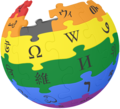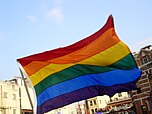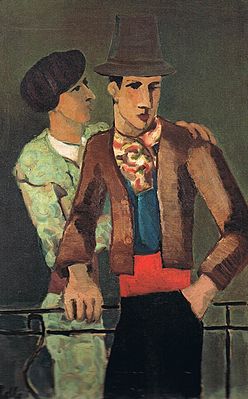Portal:LGBT
| Main page | WikiProjects & Things you can do |

|
The LGBTQ+ Portal |

|

|

|
Introduction LGBT is an initialism that stands for "lesbian, gay, bisexual, and transgender". It may refer to anyone who is non-heterosexual, non-heteroromantic, or non-cisgender, instead of exclusively to people who are lesbian, gay, bisexual, or transgender. A variant, LGBTQ, adds the letter Q for those who identify as queer (which can be synonymous with LGBT) or are questioning their sexual or gender identity. Another variation, LGBTQ+, adds a plus sign "represents those who are part of the community, but for whom LGBTQ does not accurately capture or reflect their identity". Many further variations of the acronym exist, such as LGBT+ (simplified to encompass the Q concept within the plus sign), LGBTQIA+ (adding intersex, asexual, aromantic and agender), and 2SLGBTQ+ (adding two-spirit for a term specific to Indigenous North Americans). The LGBT label is not universally agreed to by everyone that it is generally intended to include. The variations GLBT and GLBTQ rearrange the letters in the acronym. In use since the late 1980s, the initialism, as well as some of its common variants, functions as an umbrella term for marginalized sexualities and gender identities. LGBT is an adaptation of LGB, which in the mid-to-late 1980s began to replace the term gay (or gay and lesbian) in reference to the broader LGBT community. When not inclusive of transgender people, the shorter LGB is still used. (Full article...) Selected article -The legal status of transgender people varies greatly around the world. Some countries have enacted laws protecting the rights of transgender individuals, but others have criminalized their gender identity or expression. In many cases, transgender individuals face discrimination in employment, housing, healthcare, and other areas of life. A transgender person is someone whose gender identity is inconsistent or not culturally associated with the sex they were assigned at birth and also with the gender role that is associated with that sex. They may have, or may intend to establish, a new gender status that accords with their gender identity. Transsexual is generally considered a subset of transgender, but some transsexual people reject being labelled transgender. (Full article...)Selected biography -Mary Jean "Lily" Tomlin (born September 1, 1939) is an American actress, comedian, writer, singer, and producer. Tomlin started her career in stand-up comedy and sketch comedy before transitioning her career to acting onstage and on-screen. In a career spanning over fifty years, Tomlin has received numerous accolades, including seven Emmy Awards, a Grammy Award, and two Tony Awards. She was also awarded the Kennedy Center Honor in 2014 and the Screen Actors Guild Life Achievement Award in 2017. Tomlin started her career as a stand-up comedian as well as performing off-Broadway during the 1960s. Her breakout role was on the variety show Rowan & Martin's Laugh-In from 1969 until 1973. Her signature role, which was written by her then partner (now wife) Jane Wagner, was in the show The Search for Signs of Intelligent Life in the Universe, which opened on Broadway in 1985 and earned Tomlin the Tony Award for Best Actress in a Play. She won Emmy Awards for the special Lily (1973) and received a Grammy Award for Best Comedy Album for This Is a Recording (1972). (Full article...)Selected quote -
—Harvey Milk (1930–1978)
Current events
Selected image - Helmut Kolle was a German modernist painter who emigrated to France where he lived together with art collector Wilhelm Uhde for the rest of his life (which was unfortunately cut short by heart disease). Kolle's paintings almost exclusively feature males—at the start of his career rather effeminate-looking boys, sometime later muscular men, particularly sailors, toreros, and soldiers, usually in poses that are rarely overtly homosexual but certainly suggestive, at least to gay viewers. In this painting from about 1927 a torero puts his hand softly on the shoulder of a picador.
Did you know… -
This month's birthdays
Selected lists
Related portalsFeatured contentThe following articles and lists have been identified as some of the best produced by the Wikipedia community:
TopicsCategoriesAssociated WikimediaThe following Wikimedia Foundation sister projects provide more on this subject:
Discover Wikipedia using portals |
























